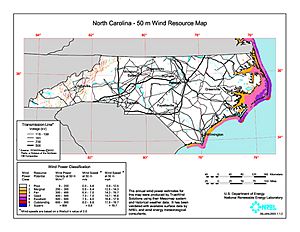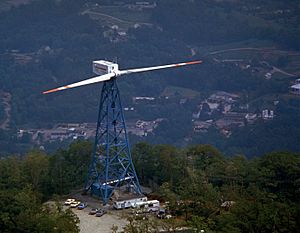Wind power in North Carolina facts for kids
Wind power in North Carolina uses the strong winds found along the coast in the east and in the mountains in the western part of the state. North Carolina also has a lot of wind energy available offshore, meaning out in the ocean. By 2015, many small wind turbine projects were built across the state. In 2016, North Carolina finished its first large wind power project. This was also the first big wind farm in the southeastern United States.
In 2019, North Carolina could produce 208 megawatts of power from wind.
Contents
Early Wind Power: The NASA Turbine
In 1977, the US government decided to build an experimental wind turbine in Boone, North Carolina. This turbine, called MOD-1, was built by General Electric in 1978. It was part of a big effort to find new ways to create clean energy.
The MOD-1 turbine was managed by NASA, the space agency. It was operated by a local electric company. The turbine stood about 131 feet (40 meters) tall. It had two long steel blades, each about 97 feet (30 meters) long. These blades spun counterclockwise. The turbine was designed to power 300 to 500 homes when the wind blew at 25 miles per hour (40 km/h).
Rules for Wind Farms
In 2013, North Carolina passed a law about building wind energy farms. This law helps wind power companies find good places to build. It also explains the steps they need to follow to get a permit from the state. A permit is like permission to start a project.
Wind Power on Land
Wind for Schools Program
The "Wind for Schools" program helps teach students about renewable energy. It is sponsored by the US Department of Energy. This program puts small wind turbines at schools across the state. These turbines help students learn about how wind energy works.
For example, in 2011, four turbines were installed at schools in the mountains. These included Alleghany High, Avery High, Watauga High, and North Wilkes Middle schools. Five more turbines were placed at coastal schools like JP Knapp, Cape Hatteras Secondary, and First Flight High. Other turbines were installed at the College of The Albemarle and in Edenton.
Progress Energy Carolinas also helped by sponsoring turbines. They put one at Hot Springs Elementary School, another at Madison High School, and a third at the Madison County Cooperative Extension Office.
North Carolina's First Large Wind Farm
The first large wind farm in North Carolina is called the Desert Wind Wind Energy Project. It was finished in 2016. This big project has 104 wind turbines. Together, they can produce 208 megawatts of power. The wind farm is located about 7.5 miles (12 km) west of Elizabeth City. It covers a large area of land.
Wind Power in the Ocean
How Much Offshore Wind Power?
North Carolina has a huge amount of wind energy available offshore. In 2009, a study looked at how possible it would be to put wind turbines in the sounds and off the coast. The study found that North Carolina has the most offshore wind potential of any state on the East Coast. It could produce 297 gigawatts of power from offshore wind within 50 miles (80 km) of the coast. That's a lot of clean energy!
Offshore Wind Energy Areas
In 2014, the US government marked out three special areas in the ocean for wind energy. These are called Wind Energy Areas (WEA). They cover a total of about 307,590 acres (1,245 square kilometers). These areas are where companies can build large offshore wind farms.
The three main areas are:
- Kitty Hawk Wind Energy Area: This area is about 122,405 acres (495 square kilometers).
- Wilmington West Wind Energy Area: This area is about 51,595 acres (209 square kilometers).
- Wilmington East Wind Energy Area: This area is about 133,590 acres (541 square kilometers).
Studying Offshore Wind
Scientists are always learning more about offshore wind. In 2015, the University of North Carolina placed two large buoys in the ocean. These buoys are about 20 miles (32 km) offshore, near Cape Hatteras. They collect important information like wind speed, temperature, and air pressure. This data helps researchers understand how to best use offshore wind energy.
Wind Power Generation Over Time
North Carolina's wind farms have been producing more and more electricity each year. The table below shows how much wind power (in million kilowatt-hours) was generated from 2016 to 2022.
| North Carolina Wind Generation (GWh, Million kWh) | |||||||||||||
|---|---|---|---|---|---|---|---|---|---|---|---|---|---|
| Year | Total | Jan | Feb | Mar | Apr | May | Jun | Jul | Aug | Sep | Oct | Nov | Dec |
| 2016 | 6 | 6 | |||||||||||
| 2017 | 469 | 25 | 43 | 53 | 57 | 49 | 35 | 28 | 25 | 40 | 38 | 28 | 48 |
| 2018 | 542 | 58 | 56 | 67 | 64 | 44 | 22 | 30 | 24 | 28 | 42 | 57 | 50 |
| 2019 | 523 | 54 | 47 | 58 | 57 | 40 | 38 | 27 | 23 | 29 | 42 | 51 | 57 |
| 2020 | 545 | 61 | 55 | 63 | 64 | 55 | 42 | 24 | 22 | 33 | 32 | 39 | 55 |
| 2021 | 505 | 46 | 57 | 60 | 51 | 40 | 28 | 30 | 17 | 30 | 44 | 56 | 46 |
| 2022 | 117 | 64 | 53 | ||||||||||



